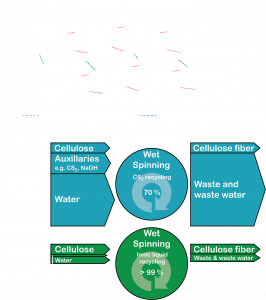[Page under construction, further images to follow]

Cellulose is known to be challenging to dissolve, and therefore process, due to the strong inter- and intra-molecular forces that exist between the individual chains. In 2002, ionic liquids were demonstrated to be effective at dissolving cellulose without the need for surface modification, unlike the commercial viscose process. However, ionic liquids are expensive and the solutions are very viscous. Thus, dipolar aprotic solvents, such as dimethyl sulfoxide, are used to reduce the viscosity and minimize the amount of ionic liquid required. This combination of an ionic liquid and co-solvent is known as an organic electrolyte solution. However, questions remained over the best choice of co-solvent and whether their use enhanced cellulose dissolution over that of the ionic liquid alone.
To address co-solvent optimization, we investigated a series of dipolar aprotic solvents and their impact on the dissolution of cellulose. By plotting the mass of cellulose dissolved divided by the mass of ionic liquid present, i.e. the dissolution efficiency, against the ionic liquid concentration, we were able to identify the optimal ionic liquid : co-solvent ratios and the most efficient combination. Furthermore, we were able to identify new, greener co-solvents that previously had not been considered despite achieving similar dissolution efficiencies.
We also developed mathematical models to confirm that the majority of co-solvents did not enhance the dissolution of cellulose over that of the pure ionic liquid. Rather, the presence of the co-solvent improved the rate of mass transfer to such an extent that the maximum dissolution was achieved in hours rather than days. The solvent molecular weight was found to be directly proportional to the ionic liquid concentration required to initiate cellulose dissolution, further supporting our conclusion. However, regression modelling suggested that a minority of solvents, including dimethyl sulfoxide, enhanced dissolution beyond that of the pure ionic liquid within a limited range. Likewise, propylene carbonate appeared to limit dissolution, which we theorized was due to it being able to interact with more than one ionic liquid molecule simultaneously.
Full details of the research described here may be found in:
Gale E, Wirawan R, Silveira R, Pereira C, Johns MA, Skaf M, Scott JL (2016) Directed discovery of greener cosolvents: new cosolvents for use in ionic liquid based organic electrolyte solutions for cellulose dissolution. ACS Sustain. Chem. Eng., 4(11): 6200-6207. doi.org/10.1021/acssuschemeng.6b02020
Gale E, Johns MA, Wirawan R, Scott JL (2017) Combining random walk and regression models to understand solvation in multi-component solvent systems. Phys. Chem., Chem. Phys., 19(27): 17805-17815. doi.org/10.1039/C7CP02873C
